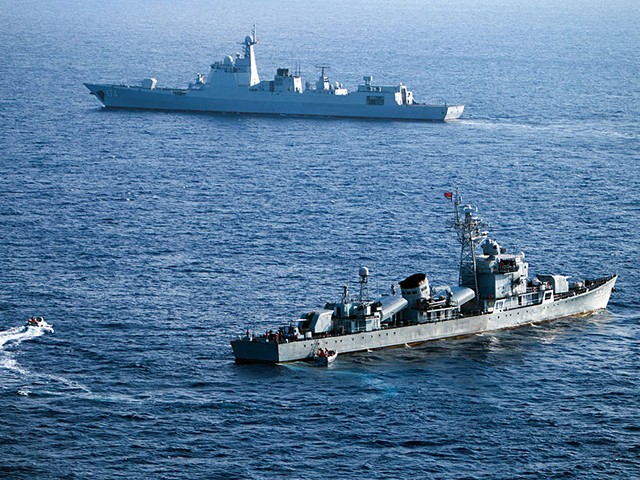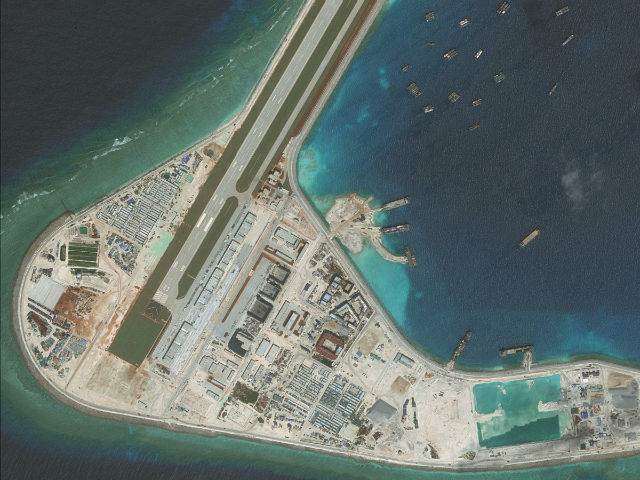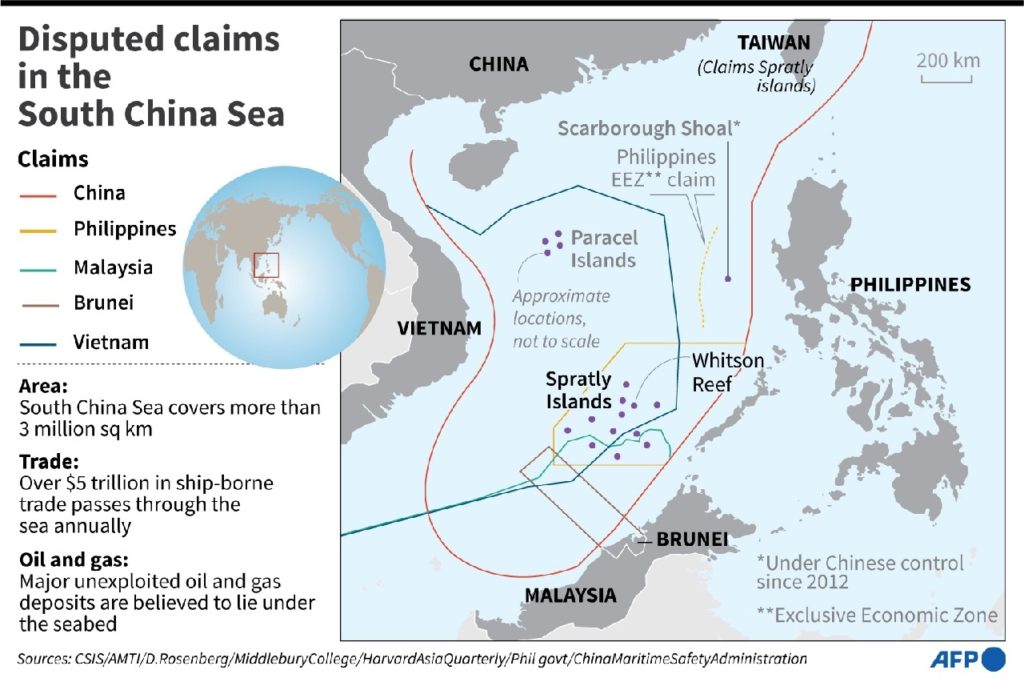U.S. Indo-Pacific commander Adm. John C. Aquilino told the Associated Press in an interview published on Sunday that China had fully militarized three artificial islands built in the territory of the Philippines as part of “the largest military buildup since World War II.”
The three artificial islands were built on Mischief Reef, Subi Reef, and Fiery Cross Reef, territories belonging to the Spratly Islands, an archipelago legally under the territory of the Philippines.
China’s presence on the islands is illegal regardless of the nature of its construction there. China claims nearly the entirety of the South China Sea, including territory belonging to the Philippines, Vietnam, Taiwan, Malaysia, and Brunei, as well as waters off the coast of Indonesia. In 2016, the Philippines won a lawsuit against China at the Permanent Court of Arbitration at the Hague in which the court ruled that China had no legal right to be present in the disputed territories, including the three reefs Aquilino discussed this weekend.
Chinese officials called the ruling a “farce” and ignored it; the government of Philippine President Rodrigo Duterte has repeatedly refused to seek enforcement of the ruling.
The Chinese government seized the three reefs – as well as several others in another chain, the Paracel Islands, disputed by the Philippines and Vietnam – and built artificial islands that Beijing claims are necessary for weather research and surveillance. Chinese dictator Xi Jinping asserted in 2015 that China would not “pursue militarization” in the Spratly Islands.

This photo taken on May 5, 2016 shows crew members of China’s South Sea Fleet taking part in a drill in the Xisha Islands, or the Paracel Islands in the South China Sea. (STR/AFP via Getty Images)
Extensive evidence since the completion of the artificial islands, including statements from the Chinese government, has suggested that Xi did not adhere to his promise.
According to the Associated Press, Aquilino described the three artificial islands as equipped with completed “missile arsenals, aircraft hangars, radar systems and other military facilities.”
“The function of those islands is to expand the offensive capability of the PRC [China] beyond their continental shores,” the outlet quoted the admiral as saying. “They can fly fighters, bombers plus all those offensive capabilities of missile systems.”
The facilities, he warned, “threaten all nations who operate in the vicinity and all the international sea and airspace.”
“I think over the past 20 years we’ve witnessed the largest military buildup since World War II by the PRC,” Aquilino said, noting that China appeared to have “advanced all their capabilities and that buildup of weaponization is destabilizing to the region.”
Multiple American presidential administrations have warned since at least 2015 that the Chinese Communist Party was seeking to build illegal military facilities in the South China Sea. The Chinese government has enthusiastically denied any plans to militarize the region for years. Xi Jinping himself denied such a plan in 2015 while visiting the White House.
“Relevant construction activities that China are undertaking in the Nansha [Spratly] Islands do not target or impact any country, and China does not intend to pursue militarization,” Xi said.
Shortly before Xi’s visit in September of that year, the People’s Daily, the official newspaper of the Communist Party, more specifically claimed that the construction in the region was necessary for civilian purposes.
“The construction of infrastructure for observation and communication is the first step towards enhancing and improving marine meteorological monitoring, warning, forecasting, prediction and scientific research,” Chinese Academy of Engineering representative Ding Yihui told the People’s Daily at the time.
Satellite images of the Spratly Islands indicated as early as 2017 that China was reinforcing its illegal claims in the region with military assets. That year, images of the three reefs Aquilino identified as fully militarized this week showed the presence of what appeared to be surface-to-air missile launch sites.
The next year, as construction of the islands concluded, China began admitting to military activity in the region. The PLA announced in June of that year that it had engaged in military drills involving “target drones” in the South China Sea, without specifying where. The exercises followed formal military activities in the general area of the South China Sea in March.
The admitted activity was significantly smaller than what U.S. intelligence officials accused China of. A month before the drone exercises, CNBC reported, citing American sources, that “quietly installed anti-ship cruise missiles and surface-to-air missile systems on three of its fortified outposts west of the Philippines in the South China Sea.” China also reportedly landed heavy bombers on Woody Island in the Paracel Islands that year.
China has maintained its claims to civilian “research” in the area despite years of evidence indicating military investment. In 2020, the Chinese Academy of Sciences’ Integrated Research Center for Islands and Reefs announced the debut of a “real-time monitoring system” on Fiery Cross Reef, allegedly meant to environmental development and surveillance to predict earthquakes and other natural disasters.

Anti-Beijing activists protest outside the Chinese consulate in Makati, Philippines on Wednesday, Nov. 24, 2021. (AP Photo/Aaron Favila)
China’s claims to environmental research in the area are particularly difficult to believe given the ecological devastation of building the artificial islands in the first place. Environmental experts have been warning since at least 2015 that China’s artificial islands would likely destroy entire habitats and destabilize much of the local food supply for people as well as animal populations.
“Building new manmade islands on top of shallow reefs is smothering them with sediment, and turning clear water muddy — the environmental damage is substantial and unprecedented in scale,” Professor Terry Hughes, a marine biologist who specializes in coral, told the Guardian in 2015.
“If you built something, if you’ve put dirt, rubble, and pavement [on top of coral reefs] … There’s no way to recover that,” John McManus, a professor of marine biology at the University of Miami in Florida, told Radio Free Asia (RFA) in 2020, lamenting that rich coral reef habitats were “gone forever.”
The construction may have destroyed critical fish stocks that help feed all of southeast Asia.
“If fish stocks collapse there, it’s not just going to hit fisherfolk in Palawan and Luzon [Philippine islands]. It’s gonna hit fisherfolk throughout the Philippine archipelago and everywhere in Southeast Asia,” Gregory Poling, director of Washington-based think tank Asia Maritime Transparency Initiative (AMTI), explained in 2019.


COMMENTS
Please let us know if you're having issues with commenting.